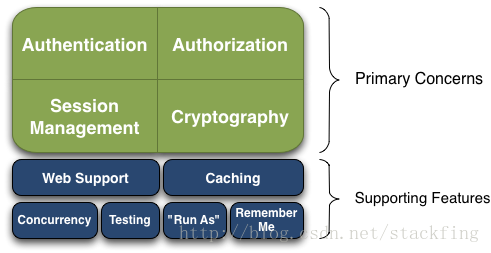您好,登錄后才能下訂單哦!
您好,登錄后才能下訂單哦!
安全無處不在,趁著放假讀了一下 Shiro 文檔,并記錄一下 Shiro 整合 Spring Boot 在數據庫中根據角色控制訪問權限
簡介
Apache Shiro是一個功能強大、靈活的,開源的安全框架。它可以干凈利落地處理身份驗證、授權、企業會話管理和加密。

上圖是 Shiro 的基本架構
Authentication(認證)
有時被稱為“登錄”,用來證明用戶是用戶他們自己本人
Authorization(授權)
訪問控制的過程,即確定“誰”訪問“什么”
Session Management(會話管理)
管理用戶特定的會話,在 Shiro 里面可以發現所有的用戶的會話信息都會由 Shiro 來進行控制
Cryptography(加密)
在對數據源使用加密算法加密的同時,保證易于使用
Start
環境
Spring Boot 1.5.9 MySQL 5.7 Maven 3.5.2 Spring Data Jpa Lombok
添加依賴
這里只給出主要的 Shiro 依賴
<dependency> <groupId>org.apache.shiro</groupId> <artifactId>shiro-spring-boot-starter</artifactId> <version>1.4.0-RC2</version> </dependency>
配置
我們暫時只需要用戶表、角色表,在 Spring boot 中修改配置文件將自動為我們創建數據庫表
server: port: 8888 spring: datasource: driver-class-name: com.mysql.jdbc.Driver username: root password: root url: jdbc:mysql://localhost:3306/shiro?characterEncoding=utf-8&useSSL=false jpa: generate-ddl: true hibernate: ddl-auto: update show-sql: true
實體
Role.java
@Data
@Entity
public class Role {
@Id
@GeneratedValue
private Integer id;
private Long userId;
private String role;
}
User.java
@Data
@Entity
public class User {
@Id
@GeneratedValue
private Long id;
private String username;
private String password;
}
Realm
首先建立 Realm 類,繼承自 AuthorizingRealm,自定義我們自己的授權和認證的方法。Realm 是可以訪問特定于應用程序的安全性數據(如用戶,角色和權限)的組件。
Realm.java
public class Realm extends AuthorizingRealm {
@Autowired
private UserService userService;
//授權
@Override
protected AuthorizationInfo doGetAuthorizationInfo(PrincipalCollection principalCollection) {
//從憑證中獲得用戶名
String username = (String) SecurityUtils.getSubject().getPrincipal();
//根據用戶名查詢用戶對象
User user = userService.getUserByUserName(username);
//查詢用戶擁有的角色
List<Role> list = roleService.findByUserId(user.getId());
SimpleAuthorizationInfo info = new SimpleAuthorizationInfo();
for (Role role : list) {
//賦予用戶角色
info.addStringPermission(role.getRole());
}
return info;
}
//認證
@Override
protected AuthenticationInfo doGetAuthenticationInfo(AuthenticationToken authenticationToken) throws AuthenticationException {
//獲得當前用戶的用戶名
String username = (String) authenticationToken.getPrincipal();
//從數據庫中根據用戶名查找用戶
User user = userService.getUserByUserName(username);
if (userService.getUserByUserName(username) == null) {
throw new UnknownAccountException(
"沒有在本系統中找到對應的用戶信息。");
}
SimpleAuthenticationInfo info = new SimpleAuthenticationInfo(user.getUsername(), user.getPassword(),getName());
return info;
}
}
Shiro 配置類
ShiroConfig.java
@Configuration
public class ShiroConfig {
@Bean
public ShiroFilterFactoryBean shiroFilterFactoryBean(SecurityManager securityManager) {
ShiroFilterFactoryBean shiroFilterFactoryBean = new ShiroFilterFactoryBean();
shiroFilterFactoryBean.setSecurityManager(securityManager);
Map<String, String> filterChainDefinitionMap = new LinkedHashMap<String, String>();
//以下是過濾鏈,按順序過濾,所以/**需要放最后
//開放的靜態資源
filterChainDefinitionMap.put("/favicon.ico", "anon");//網站圖標
filterChainDefinitionMap.put("/**", "authc");
shiroFilterFactoryBean.setFilterChainDefinitionMap(filterChainDefinitionMap);
return shiroFilterFactoryBean;
}
@Bean
public DefaultWebSecurityManager securityManager() {
DefaultWebSecurityManager defaultWebSecurityManager = new DefaultWebSecurityManager(myRealm());
return defaultWebSecurityManager;
}
@Bean
public MyRealm myRealm() {
MyRealm myRealm = new MyRealm();
return myRealm;
}
}
控制器
UserController.java
@Controller
public class UserController {
@Autowired
private UserService userService;
@GetMapping("/")
public String index() {
return "index";
}
@GetMapping("/login")
public String toLogin() {
return "login";
}
@GetMapping("/admin")
public String admin() {
return "admin";
}
@PostMapping("/login")
public String doLogin(String username, String password) {
UsernamePasswordToken token = new UsernamePasswordToken(username, password);
Subject subject = SecurityUtils.getSubject();
try {
subject.login(token);
} catch (Exception e) {
e.printStackTrace();
}
return "redirect:admin";
}
@GetMapping("/home")
public String home() {
Subject subject = SecurityUtils.getSubject();
try {
subject.checkPermission("admin");
} catch (UnauthorizedException exception) {
System.out.println("沒有足夠的權限");
}
return "home";
}
@GetMapping("/logout")
public String logout() {
return "index";
}
}
Service
UserService.java
@Service
public class UserService {
@Autowired
private UserDao userDao;
public User getUserByUserName(String username) {
return userDao.findByUsername(username);
}
@RequiresRoles("admin")
public void send() {
System.out.println("我現在擁有角色admin,可以執行本條語句");
}
}
展示層
admin.html
<!DOCTYPE html> <html xmlns:th="http://www.thymeleaf.org"> <html lang="en"/> <head> <meta charset="UTF-8"/> <title>Title</title> </head> <body> <form action="/login" method="post"> <input type="text" name="username" /> <input type="password" name="password" /> <input type="submit" value="登錄" /> </form> </body> </html>
home.html
<!DOCTYPE html> <html xmlns:th="http://www.thymeleaf.org"> <html lang="en"/> <head> <meta charset="UTF-8"/> <title>Title</title> </head> <body> home </body> </html>
index.html
<!DOCTYPE html> <html xmlns:th="http://www.thymeleaf.org"> <html lang="en"/> <head> <meta charset="UTF-8"/> <title>Title</title> </head> <body> index <a href="/login" rel="external nofollow" >請登錄</a> </body> </html>
login.html
<!DOCTYPE html> <html xmlns:th="http://www.thymeleaf.org"> <html lang="en"/> <head> <meta charset="UTF-8"/> <title>Title</title> </head> <body> <form action="/login" method="post"> <input type="text" name="username" /> <input type="password" name="password" /> <input type="submit" value="登錄" /> </form> </body> </html>
總結
這個小案例實現了根據角色來控制用戶訪問,其中最重要的就是 Realm,它充當了Shiro與應用安全數據間的“橋梁”或者“連接器”
以上就是本文的全部內容,希望對大家的學習有所幫助,也希望大家多多支持億速云。
免責聲明:本站發布的內容(圖片、視頻和文字)以原創、轉載和分享為主,文章觀點不代表本網站立場,如果涉及侵權請聯系站長郵箱:is@yisu.com進行舉報,并提供相關證據,一經查實,將立刻刪除涉嫌侵權內容。